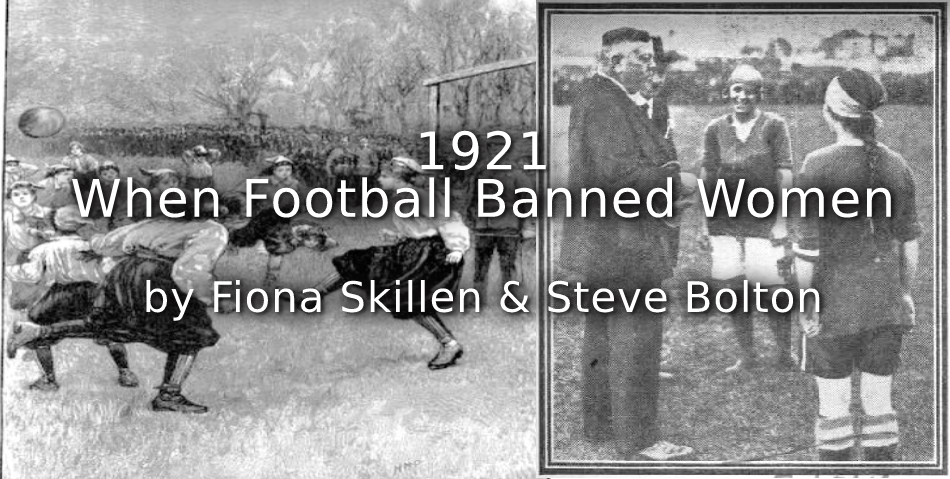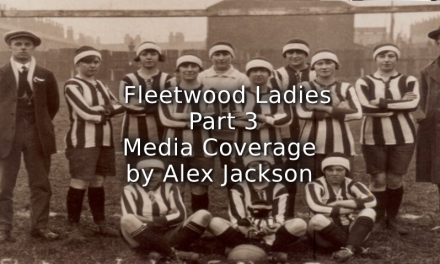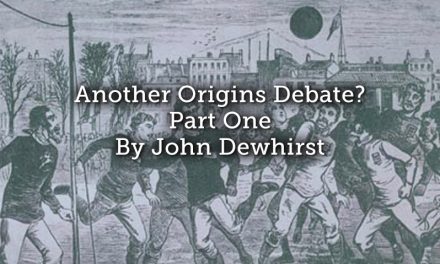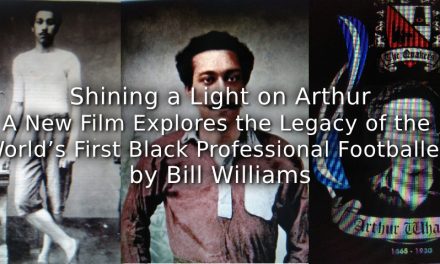
Go Away, We’re Busy
Source: British Newspaper Archive
The English FA Ban – 5th December 1921
100 Years ago, the highly influential English Football Association (FA) took it upon themselves to ban women footballers from grounds affiliated to their organisation. The ban went much further than this. The ban was in place for approximately 50 years and during that time male clubs, players and referees were frequently warned and sanctioned for helping with the women’s game, even when the matches which were being played were to raise funds for charities. Because of the de facto power of the English FA the ethos of the ban spread far beyond England, both informally and formally as other Football Associations adopted their own bans. The results were to have a profound effect on the development of women’s football. The inbuilt misogyny between men and women in sport was further entrenched by the ban for many, many years and continued long after the ban had been ‘lifted’ around 1970. A consequence of the ban is that many modern women footballers regard themselves as pioneers – and rightly so. It is a sad outcome of the ban that every generation of women footballers have had to be pioneers. One point that the authors would like to make is that this article is not about ‘nasty men’ banning women. There were very many good men who supported the women’s game. Instead, we write this piece as a way of encouraging people to think more deeply about the contexts in which the ban took place, as it was a time of enormous social change. A simplistic, and often used explanation, is that it came about because of the ‘Patriarchy Striking Back’, by ‘men’ wanting to take back control of football in the aftermath of World War One. This was indeed a factor, but it is one factor amongst many others as we will discuss in this blog.
Aspirational Advert & Views on Women’s Football

“The Lure of Crepe-De-Chine”
Source: BNA Illustrated London News Saturday 1 April 1922 p26
“They are like nice, clean, merry boys…”
There is one good thing to be said for women footballers: they have raised a large sum of money for good causes. We have the French women players here now. A very hefty, high-spirited lot they looked as I saw them in a charabanc last week. All the same, I hold to the theory that football is no game for women. It cannot be denied that in manners and modes of life a large percentage of the girls of today are more boyish than boys. They are like nice, clean, merry boys, and so far show no more disposition to take up football as a game for women generally than to adopt Navy, Army, or Air Force as professions. Hockey as played by mixed teams of men and girls has gone out of fashion, because the girls were disfigured by bruises, and had to forgo pleasanter and more suitable amusements, such as dancing and theatre-going, until their eyes, arms, or other exposed parts of their persons were less discoloured. The footballers of our sex are of the class who work in factories, and who found their feet during the war and now desire to use them in kicking. “Footer” is the people’s game. It is quite as usual to hear girls discuss the points of well-known players as to hear others discussing the performances of racehorses. It is alright so long as girls keep vicariously to these interests, but no one who admires them likes to see them mixed up in football scrimmages or to see them when they emerge, therefrom.
The image and text above form part of an article which appeared in “The World of Women” section of the Illustrated London News in 1922. Views similar to this appeared regularly in many newspapers and magazines, debating in earnest whether football ‘damaged’ women preventing motherhood. These arguments, which surfaced in the Victorian era when large numbers of women first took part in active sports, were sidelined during the WWI but were resurrected in its aftermath. They held some weight because they were underpinned by medical reports as this was at a time when female physiology was less understood than it is today.
Item 5 – The Ban: A Swift and Business-Like Decision

Photo of the English FA Minute Book from 1921
Book is on display at the English National Football Museum, Manchester
Source: Author’s Collection, Courtesy English NFM
At 3pm on Monday 5th December 1921, the English FA Consultative Committee met at its headquarters at Russell Square. As usual, they had a number of items to transact and here is Item 5:
5. Women’s Football Matches. The following Resolution was adopted:-
Complaints have been made as to football being played by women, Council feel impelled to express their strong opinion that the game of football is quite unsuitable for females and should not be encouraged.
Complaints have also been made as to the conditions under which some of the matches have been arranged and played, and the appropriation of receipts to other than charitable objects.
The Council are further of the opinion that an excessive proportion of the receipts are absorbed in expenses and an inadequate percentage devoted to charitable objects.
For these reasons the Council requests the Clubs belonging to the Association refuse the use of their grounds for such matches.
The man who conducted this meeting and signed off this ban was Frederick (later ‘Sir’) Wall, Secretary of the FA. There are two questions that should be asked in even a rudimentary analysis of the ban:
- What sort of organisation was the English FA in 1921?
- Who was Frederick Wall and what were his reasons for signing the ban?
Why I Banned Women’s Football

Autobiography “50 Years of Football 1884 – 1934” by Sir Frederick Wall
Source: Author’s Image
Frederick Wall – In His Own Words
Frederick Wall wrote his autobiography in 1935. For 50 years he had been a towering figure in the administration of English football. This 200 page, 21-chapter book recounts his time as secretary of the English Football Association. He addresses the subject of women’s football in a short paragraph of three sentences in Chapter 1:
I was asked to referee the first women’s football match at Crouch End. I declined, but I went to see the match and came to the conclusion that the game was not suitable for them. Someone declared that one of the players was a ‘Tommy’ made up as a woman. The Football Association have discouraged this invasion of the ‘eternal feminine,’ just as they have discountenanced Sunday Football.
This is remarkable. The man who signed off the ban in 1921 is referencing a game played in 1895, 26 years earlier. It appears that he had been prejudiced against women’s football for his entire life.
Folk Football vs Modern Football
There are no ‘De Jure’ standards for classifying women’s football. ‘Folk Football’ is a useful umbrella term to describe anything that isn’t formal modern association-style football as we would understand it today and includes 19th century games, mixed games, fancy dress games, married vs single at annual fetes, etc. This is not to devalue the social worth of these games which from their early origins continued to take place, often in the same period and location with the more ‘serious’ or formalised women’s football. The formalised football, a forerunner to the modern game, was given a tremendous, some would argue seismic, boost due to the First World War. However, the football that Frederick Wall witnessed in 1895 would have been of a primitive, folk classification and nothing like the sophisticated St Helens versus Dick Kerr Ladies matches he was actually banning. The timeline below which shows some key dates from early women’s football illustrates just how far the women’s game had developed from Sir Frederick’s first encounter with it.

1895 Crouch End Game in Context
Source: Steve Bolton and Fiona Skillen
Rutherglen Ladies F.C. Exhibition 2021
Courtesy of Scottish National Football Museum, Hampden
Football Circa 1895 Influenced ‘The Ban’

British Ladies Football Club in Action at Crouch End
Source: BNA The Graphic Saturday 30 March 1895 p3
“Play in the First Half was Beyond Criticism, and, Indeed, Description”
The Standard commented on Monday 25 March:
Goals were occasionally taken, in a kind of inconsequential way, but there was never any development of exciting play, which might have distracted the attention of the spectators from the fair players of the game. Everybody saw the huge joke, except for a few unappreciative people, of course, who called it slow, and among these were probably the individuals who got up a fight outside the ropes and caused the police to be called in.
This is the game that Frederick Wall is using in his autobiography to justify the banning of women’s football.
The Effects of the Ban: Women’s Football in the British Media

Chart of Key BNA Search Terms
Source: Authors’ Analysis of BNA Data
The vast majority of women’s football in this era was played in football seasons (Sep – May) like the men’s football and this is the best way to analyse it. However, the graphic above shows the number of ‘hits’ for the three most obvious search terms* in media publications across England, Scotland, Wales and Northern Ireland. This chart highlights how much discussion there was in the press about women’s football for the period 1910-1929. The data also mirrors the statistics we have of the numbers of games being played in these years. When combined this information therefore provides a good illustration of the patterns of high-profile women’s football across calendar years rather than seasons and the media’s engagement with it. It is interesting to note the astonishing growth in publicity during 1920 and 1921 even after many teams ceased in 1919. It is easy to see why the English FA had become alarmed at the growth of women’s football as 1921 drew on and decided that this was a ‘problem for someone else’.
*The search terms used were: “Ladies Football”, “Womens Football”, “Girls Football”.
This is not an academic article and this data should be treated as illustrative, fuzzy logic to give an indicative overview of the pattern of games. It is also worth noting that this research is based only on digitised media sources so it is likely that the true figures are indeed higher than noted here, however we believe that this does however give a good indication of the trends.
The Impact of the Ban – Far and Wide
In Scotland there was no formal ban relating to women’s football at this time; that did not happen until 1949 when the Scottish Football Association (SFA) issued a formal ban which mirrored the English FA ban. However, the SFA almost immediately began to informally discouraged their members from allowing women’s matches to take place on their pitches and individuals from participating in games, something which they had done in the early days of the women’s game during the late C19th but put to one side for the duration of WWI. On the occasions when they were approached for permissions for specific ‘one off’ games they always declined. For instance in 1925 when Femina Sport of Paris played two games against the Dick Kerr Ladies in Scotland the game at Queen of the South was subject to an SFA ban and the one at Kilmarnock wasn’t. The FA in Northern Ireland did not impose a ban and in the early 1930s enjoyed a ‘golden period’ of women’s football before significant societal disturbance forced a rapid decline in high profile women’s football. Over the years the Welsh Football Association could not seem to make up its mind whether it was for or against women’s football, at some points vigorously supporting it and at others condemning it. So it is important to recognise that the FA’s ban was not adopted wholesale by other UK and Ireland associations, although many were adverse to the growth of the women’s game within their respective nations.
In spite of the hostile atmosphere across the UK and internationally several women’s teams developed in Scotland in this period such as Cowdenbeath, Dumfries Ladies and Auchterderran. The most successful of these was Rutherglen Ladies F.C, who were established in September 1921 and who toured extensively throughout Scotland, Ireland and England until 1939.
Find out more about this team in our earlier blog: https://www.playingpasts.co.uk/articles/football/womens-football-in-interwar-scotlandsadie-smith-and-the-legendary-rutherglen-ladies-fcpart-1/
1922 English FA is Regarded as a “Bulwark Against Niagara of Corruption”

Mr J Clegg (Chairman), Lord Kinnaird (President), Mr F J Wall (Secretary)
English FA Committee Room, Russell Square, London
Source: Illustrated Sporting & Dramatic News, Saturday 15 April 1922 p21
The Illustrated Sporting and Dramatic News printed the above article in 1922 in the off-season after banning women’s football half-way through the previous season. The text read:
The large illustration is one of the committee rooms at Russell Square, WC, where a few disinterested men stand as a bulwark of the professional game against the Niagara of corruption which constantly threatens its existence.
The FA at the time had a metropolitan bias. They saw themselves as guards protecting a very ‘pure’ product: Association Football by their definition. Frederick Wall had held the position of Secretary of the FA from 1895. Wall was a metropolitan lawyer. He entered football legislation in 1881 as a member of the London FA and he represented Middlesex on the Football Association Council from 1891 to 1895. Wall inherited the role from Charles William Alcock who had held the position from 1870. Alcock’s family had a marine insurance business in the City of London. Collectively they regarded football as a pure ‘Corinthian’ ideal which was in danger of being distorted by the way it was played professionally, especially in the North of England. Wall eventually went on to become a Director of Arsenal. He was knighted for his services to football.
FA Policing ‘Unauthorised’ Football: Disciplinary Measures by Lancashire FA

Players who Played ‘Unauthorised Football’ were Invited to ‘Confess’
Source: BNA Lancashire Evening Post Saturday 20 September 1919 p1
In a long article published in November 1919 about ‘Unauthorised Football’ the Lancashire Evening Post reported:
Mr Lewis also promised that others who had taken part would be forgiven if they would write a letter acknowledging what they had done and giving a similar undertaking. He stated that there was no objection to referees taking charge of boys and other games so long as the matches had not been banned by the association, but he gave warning that referees taking part in football which had come under the ban would be struck off the list.
Mr R Holmes (Dick, Kerr’s) inquired whether the association would give a club consent to run a medal competition until the third Saturday in May to counteract unauthorised football. Mr Lewis pointed out that the competition would have to finish on the first Saturday in May unless the receipts were for charitable purposes or some other approved object.
The FA were an all-powerful body, similar to a medieval guild in some ways. They controlled the men’s game with a pervasive, controlling diktat which allowed no variation. They sought to preserve what they defined as Association Football with an almost religious fervor. It would appear that football as played by women footballers would have little, if no chance of meeting their criteria for ‘Association Football’.
“The Game of Football is Quite Unsuitable For Females”

Dick Kerr Ladies “British Champion” + “World Champion” Postcards
Source: Lizzy Ashcroft Collection
Association Football 100 Years Ago
Women could not play “Association Football” 100 years ago because they were not members of the Association. Football was very different then and so were women. It is easy to look at this from a modern point of view and not take into consideration three important points.
- Football was probably a more violent game back then. Charging was allowed for instance and goalkeepers didn’t have the protection bemoaned about by most modern forwards!
- Another important point to remember is that women were a lot different physically than now. Look at the gap above the women’s heads in the two popular postcards above. Lizzy Ashcroft (Steve’s granny) is pictured in the “World Champion” postcard above holding onto her friend Lily Parr (holding ball). Lizzy was 5ft 8in tall (~1.73m). He knows this from both comparative pictures where she is standing next to his 5ft 10in father and from newspaper reports of football matches she played in. The Dick Kerr Ladies were regarded as ‘a bunch of bruisers’ compared to most other women’s football teams of the time and Lizzy was regarded as one of the bruisers! Most of the other teams were smaller. It is also worth noting that a lot of women’s football teams in that era were made up of young girls aged from 12 years old who had not reached physical maturity.
- Heading the ball was a key part of the men’s game of Association Football. This is a difficult skill which often takes many years to learn. The early footage of a number of women’s games (widely available to view on British Pathe and BFI) show very little heading of the ball. Very few of the thousands of articles of that era refer to headed goals in women’s games.
It is important to note here that we are not saying that football was unsuitable for women but the points above do not appear to have been taken into consideration by researchers when we ask the question: Would the typical 1921 women’s football game have met Frederick Wall’s criteria for ‘Association Football’?
“Excessive Expenses”

Cecil Kent, Westminster School – Champion of Women’s Football
Source: Lizzy Ashcroft Collection
“Are their feet heavier on the turf than the men’s feet?”
Cecil Kent’s letter was read out at the FA meeting on Monday 5th December 1921 and was very widely reported. A copy of the letter is not known to exist but here is an attempt to reconstruct the letter which was heavily quoted by the newspapers of the day:
Dear Mr Frederick Wall – FA Secretary
I may mention that in the present and past seasons I have watched about 30 ladies football matches between various teams. I have met all the organisers of the teams and all the girls in the elevens; I have travelled with them frequently by road and rail; I have attended the various functions to which they have been invited and have met Lord Mayors and Mayors and also the officials of the local charities and football clubs concerned.
On all hands I have heard nothing but praise for the good work the girls are doing and the high standard of their play. The only thing I now hear from the man in the street is, Why have the F.A. got their knife into girls’ football? What have the girls done except to raise large sums for charity and to play the game? Are their feet heavier on the turf than the men’s feet?
The girls of the Dick, Kerr’s team are all workers, who, when they are away playing football, draw from their “gates” the equivalent of their loss of time – generally not more than 10 shillings each for a whole day.
He continued, regarding their entertainment to lunch and tea, saying that:
… they are often given an insufficient meal and something in the nature of a sacred concert instead of a jazz dance, while invariably they are regaled with a dozen long and more or less dull speeches by the local mutual admiration society, who in every town say almost the same thing until ‘bored stiff’ represents the girls’ feelings.
Major Kent points out there are many reasons that their expenses sometimes appear a trifle high. Firstly a girls’ team, for considerations of health, must carry more reserves than are necessary for men’s clubs. Secondly, when arriving home by train late at night or in the early hours of the morning, taxis must be hired to take girls home to outlying districts.
I can only say that I know that no unnecessary expenses are ever charged by the reputable girls football clubs, and that the charities alone benefit from the matches.
Hitherto the F.A. have made no attempt to control girls’ football, but if they only legislate the girls’ clubs will accept their regulations cheerfully and abide by them faithfully. The excellent behaviour and obedience of the girls on the field of play is a sufficient indication of that, and I am sure Mr Howcroft or any of the other leading referees who have controlled games will testify to this.
Before your council takes any drastic or final step on this important matter, I sincerely hope that they will seriously consider the question of legislating for ladies’ football and that in any case they will refrain from debarring the girls from using their grounds when available. Such a ban would raise two main points.
Firstly, by act of the F.A., every Lord Mayor, Mayor, unemployed fund, hospital, and other charity in England would be deliberately deprived of what is now a little gold-mine to them. I am quite aware that the F.A. Charity matches annually raise about £20,000, but the girls supplement to this of £100,000 in two years can hardly be ignored.
Secondly, a little gratitude is undoubtedly due to the girls themselves for all they have done and are willing to continue to do. The greatest reward that can be given to them by the F.A. is to be allowed to go on playing the game. That is all they ask. For football they have given up other amusements and other forms of sport, although in many cases lack of means and opportunity do not grant them much choice of the latter. Many of the girls have now played continuously, winter and summer, for four years, and they have become confirmed footballers.
Willfully to deprive them now of the game they love would be far worse than to pass an Act of Parliament forbidding all confirmed golfers ever to set foot on a golf course again. For one thing, golf is a selfish game, whereas girls’ football is utterly unselfish and supremely useful.
Yours sincerely, Cecil Kent
There are a couple of key points to make here. Vast amounts of money were being raised in largely unregulated circumstances. It would be impossible therefore for women’s football teams to answer the charges being made by the FA. When the glamorous 1925 tour by Femina Sport with the Dick Kerr Ladies is analysed, the costs of putting on the tour left little profit for the Charity involved despite the large incomes. The tour was audited and monitored by the Shipwrecked Mariners Society and up to 50% of the gate income would be needed to cover costs. Cecil Kent makes this point in his eloquent letter above. The other point is that the most important women’s football team manager Alfred Frankland of the Dick Kerr Ladies habitually inflated the crowd figures to promote the team legend. In some ways without realising it he was helping to sow the seeds of the destruction of women’s football as the receipts for charity would not match the reported crowds! There were by the time of the ban several high-profile newspaper reports questioning the amount of money being received by charity. This is not something that an organisation like the FA of the time could tolerate.
1921 October – The Ban had Already Happened!

One of a Number of Articles in Published in October
Source: BNA Dundee Evening Telegraph Tuesday 18 October 1921 p11
The Real Ban Resolution
Virtually all high profile women’s football on FA Associated pitches came to an abrupt halt at the end of September 1921 with the exception of the famous and influential Dick Kerr Ladies because the ideas underpinning the ban were already falling into place as early as late September of that year.
On Monday 10th October 1921 the Minutes of the English FA Council meeting record:
Ladies’ Football Matches. The Council decided that Clubs must not permit matches between ladies’ teams to be played on their grounds unless sanction for such matches is first obtained from the Football Association. It will be a condition of any application granted that the Club on whose ground the match is played shall be responsible for the receipts and payments and a Statement of Account must be sent to the Association showing how the receipts were applied.
The FA’s Emergency Committee had already met on 3rd October to apply the above stringent ruling to the proposed Dick Kerr Ladies vs ‘South of England’ game at Ashton Gate, the home of Bristol City FC and therefore subject to FA rules. Finding high profile women’s games played on FA affiliated pitches involving only teams other than the Dick Kerr Ladies is difficult. The other top sides of the day such as St Helens, Stoke, Bath, Fleetwood, Chorley, Plymouth, Heys Brewery Bradford, Huddersfield Atalanta were able to register less than a handful of games of this nature during October and November. On Thursday 24th Plymouth thrashed Seaton 9 – 0 at Fair Field, Winchester in the first recorded women’s game for Winchester.

The Mayor Winchester Greeting the Seaton & Plymouth Captains
Source: Daily Mirror, Saturday 29th October 1921, p6
Unfortunately, the pitch was the home pitch of the FA affiliated Winchester FC and permission had not been obtained. There had already been a number of unseemly rows in the Western Morning News about funding, payments, player selections, and paid ‘ringers’ involving Plymouth. The team above would shortly rebrand themselves at Plymouth International Ladies FC to disassociate from the breakaway Plymouth and District Ladies Amateur Athletic FC who had formed on Friday 21 October. The FA minutes shortly after this game formally record Winchester FC being censured for permitting the game without obtaining permission. The Club were ordered to pay a local charity the amount that they received as their share of the gate receipts.
Conclusion
Many people know about the FA ban. With the centenary of the ban falling on 5th December 2021 this seemed like a good time to stop and reflect on some of the lesser-known aspects of its introduction. We hope that this blog has not only unearthed some original perspectives, but that it will encourage readers to think more critically about why the ban was introduced, what motivated those who introduced it and the wider implications it had on the growth and development of women’s football in England and beyond.
The authors would also like to note that they would like this article to be viewed in a positive light. The actions of the various Football Associations over the past one hundred years do not reflect well. This is a phenomenon which affects many other organisations across society when viewed with a modern, critical lens and sensibility. Recent years have seen all of the Football Associations make strenuous efforts to improve and support the women’s game from grassroots through to the professional game. There is and always will be more to do, but the authors would like to make it clear that we applaud and support these efforts. However, we believe that understanding the barriers and obstacles that the women’s game has faced in the respective nations of the UK and Ireland is central to its future development and success, because if you don’t understand your past then how can you plan for your future?
Article © of Fiona Skillen and Steve Bolton






Trackbacks/Pingbacks